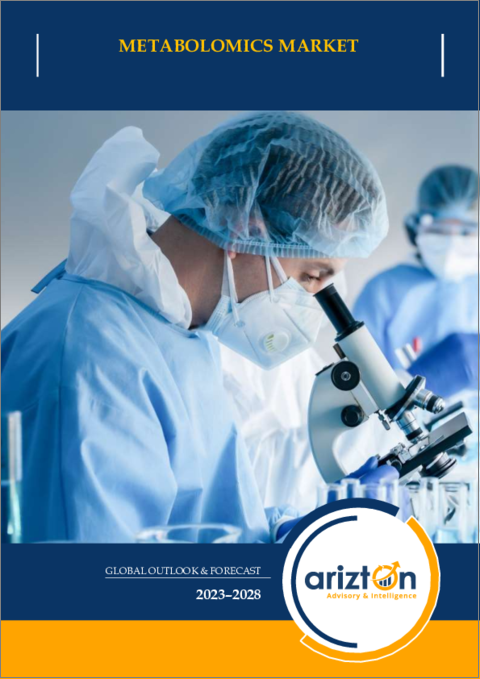|
|
市場調査レポート
商品コード
1306058
メタボロミクス:世界市場の展望・予測 (2023-2028年)Metabolomics Market - Global Outlook & Forecast 2023-2028 |
||||||
|
|||||||
| メタボロミクス:世界市場の展望・予測 (2023-2028年) |
|
出版日: 2023年07月12日
発行: Arizton Advisory & Intelligence
ページ情報: 英文 305 Pages
納期: 即納可能
|
- 全表示
- 概要
- 目次
世界のメタボロミクスの市場規模は2022年から2028年にかけて12.84%のCAGRで成長すると予測されています。
メタボロミクスは食品の安全性と品質管理にとってますます重要なツールになりつつあります。メタボロミクスによって、研究者や生産者は食品の化学組成を評価でき、潜在的に有害な物質の検出や食品全体の品質の監視が可能となります。これらの要因がメタボロミクス市場の成長にプラスの影響を与えると予測されています。また、メタボロミクスは、癌、糖尿病、肥満、心臓病、アルツハイマー病、パーキンソン病など、さまざまな疾患の研究に応用され、急速に発展している研究分野でもあります。
当レポートでは、世界のメタボロミクスの市場を調査し、市場の定義と概要、市場機会・市場動向、市場影響因子の分析、市場規模の推移・予測、各種区分・地域別の詳細分析、競合情勢、主要企業のプロファイルなどをまとめています。
目次
第1章 調査手法
第2章 調査目的
第3章 調査プロセス
第4章 調査対象・調査範囲
第5章 レポートの前提・注記
第6章 重要考察
第7章 市場概要
第8章 イントロダクション
第9章 市場機会・市場動向
- 植物および環境研究におけるメタボロミクス
- 食品の安全性と品質管理におけるメタボロミクスの需要
- メタボロミクス研究への資金の増額
第10章 市場成長の実現要因
- 精密医療におけるメタボロミクスの応用
- 対象疾患の発生率の増加
- 医薬品開発におけるメタボロミクスの需要
第11章 市場抑制要因
- 生物学的サンプルの複雑さと多様性
- ツールや器具の高コスト性
- 検査およびデータ処理に関連する問題
第12章 市場情勢
- 市場概要
- 市場規模・予測
- 市場機会
- ファイブフォース分析
第13章 技術
- 市場スナップショット・成長エンジン
- 市場概要
- 検出法
- 分離法
- バイオインフォマティクスツール&サービス
第14章 用途
- 市場スナップショット・成長エンジン
- 市場概要
- 医療および臨床研究
- 植物および食品科学
- バイオテクノロジー
第15章 エンドユーザー
- 市場スナップショット・成長エンジン
- 市場概要
- スタンドアロンメタボロミクスサービスプロバイダー
- 製薬会社およびバイオテクノロジー企業
- 研究および臨床ラボ
- その他
第16章 地域
- 市場スナップショット・成長エンジン
- 地域概要
第17章 北米
第18章 欧州
第19章 アジア太平洋
第20章 ラテンアメリカ
第21章 中東・アフリカ
第22章 競合情勢
- 競合概要
- 市場シェア分析
第23章 主要企業プロファイル
- AGILENT TECHNOLOGIES
- BIO-RAD LABORATORIES
- DANAHER
- PERKINELMER
- THERMO FISHER SCIENTIFIC
第24章 他の有力ベンダー
- ADVION
- BGI
- BIOCRATES LIFE SCIENCES
- BRUKER
- LECO
- MERCK KGAA
- SCION INSTRUMENTS
- SHIMADZU CORPORATION
- WATERS
第25章 メタボロミクスサービスプロバイダー
- CREATIVE PROTEOMICS
- HUMAN METABOLOME TECHNOLOGIES
- METABOLON
- METWARE BIOTECHNOLOGY
- MS-OMICS
- VPROTEOMICS
第26章 レポート概要
- 重要ポイント
- 戦略的提言
第27章 定量的サマリー
第28章 付録
The global metabolomics market is expected to grow at a CAGR of 12.84% from 2022 to 2028.
MARKET TRENDS & DRIVERS
Growing Demand for Metabolomics in Food Safety and Quality Control
Metabolomics is becoming an increasingly important tool for food safety and quality control due to its ability to analyze the chemicals produced by organisms as they interact with their environment. Metabolomics allows researchers and producers to assess food's chemical composition, enabling them to detect potentially harmful substances and monitor the overall quality of food. Such factors are projected to affect the metabolomics market growth positively. Metabolomics can also identify adulterated foods, diagnose food-related illnesses, and determine the chemical composition of food-processing by-products. All of these uses can help producers provide consumers with safer and higher-quality food products and help ensure compliance with food safety regulations.
Increasing Funding for Metabolomics Research
Increasing funding for metabolomics research would allow researchers to explore further the biochemical processes occurring in organisms. Metabolomics studies the comprehensive view of all the molecules, or metabolites, in the body, which provides an in-depth understanding of the metabolic networks involved in diverse physiological and pathological conditions. More resources allocated to this field of research would enable scientists to understand better the connections between molecular events and their effects on an organism's health. Research studies may also identify novel biomarkers that target specific aspects of metabolism, potentially aiding in developing more effective diagnostics for diseases and other conditions. Additionally, increased investment in metabolomics could facilitate the discovery of new drug targets and lead to the development of drugs with fewer side effects. The implications of research in this field can lead to a better understanding of the metabolic pathways in humans and other organisms and ultimately provide more personalized and effective treatments.
Growing Rate of Target Diseases
Metabolomics is a rapidly growing field of research that is being applied to studying various diseases, including cancer, diabetes, obesity, heart disease, Alzheimer's disease, and Parkinson's disease. By studying the different metabolites in an individual's body, researchers can gain valuable insight into the biochemical processes and potential causes of various diseases. The metabolomics market has paved the way to provide a better understanding of the molecular pathways and biochemical processes involved in the progression of a particular disease. By studying the metabolic pathways of a given disease, it may be possible to identify potential targets for therapeutic interventions.
SEGMENTATION INSIGHTS
INSIGHTS BY TECHNOLOGIES
The detection method technologies segment dominated the global metabolomics market, with a share of over 44% in 2022. Metabolomics is a powerful tool in biology and biochemistry, providing insights into the body's metabolic and physiological processes. Over the last decade, technological advances have made metabolomics increasingly accessible and powerful. One important technology used in metabolomics is mass spectrometry. Mass spectrometry involves passing an ionized sample through a vacuum chamber, where it is broken down into its component elements. These mass spectra can then be used to identify and quantify the different metabolites present in a sample. Mass spectrometry is used in metabolomics to analyze complex metabolic mixtures and to determine the concentration of various metabolites in a sample.
Segmentation by Technologies
- Detection Methods
- Separation Methods
- Bioinformatics Tools & Services
INSIGHTS BY APPLICATION
The global metabolomics market by application is segmented into medical & clinical research, plant & food science, and biotechnology. Metabolomics is an ever-growing field of research that is gaining increasing attention due to its potential in medical and clinical applications. The medical and clinical applications of metabolomics are numerous. They can be used to diagnose and monitor diseases and study the effects of drugs, toxins, and other environmental factors on health. Metabolomics can provide insight into the molecular basis of diseases and the mechanisms of the action of drugs. This information can be used to improve drug design and to identify novel therapeutic targets. Metabolomics can also be used to predict drug response in individuals and to identify biomarkers that can be used to evaluate health status. Such factors have helped the medical & clinical research application segment to dominate the global metabolomics market during the forecast period.
Segmentation by Application
- Medical & Clinical Research
- Plant & Food Science
- Biotechnology
INSIGHTS BY END-USER
The standalone metabolomics service providers segment accounted for the largest global metabolomics market share in 2022. Metabolomics service providers are becoming increasingly important in the field of research. By offering specialized services, such as sample preparation and analysis, data analysis and interpretation, and metabolite identification and quantification, these companies are helping researchers better understand how cells work and how diseases develop. As the demand for metabolomics services continues to grow, more companies are entering the market and offering specialized services to meet the needs of researchers.
Segmentation by End-user
- Standalone Metabolomic Service Providers
- Pharma & Biotech Companies
- Research & Clinical Laboratories
- Others
GEOGRAPHICAL ANALYSIS
North America dominated the global metabolomics market share, accounting for over 40% in 2022, mainly due to the developed infrastructure, increased government projects based on various new biological compound syntheses, advances in metabolomics technologies, and many research laboratories performing studies on various diseases. Metabolomics also has a wide range of applications other than healthcare, such as plant & food science, biofuel, and bioengineering. The most important factor that drives the regional market is the rise in investments in metabolomics. The major contributors in North America are the U.S. and Canada. Arizton predicts that the market in this region will grow at a healthy rate and dominate the global metabolomics market during the forecast period.
Segmentation By Geography
- North America
- The U.S.
- Canada
- Europe
- Germany
- France
- The U.K.
- Italy
- Spain
- APAC
- China
- Japan
- India
- South Korea
- Australia
- Latin America
- Brazil
- Mexico
- Argentina
- Middle East & Africa
- Turkey
- South Africa
- Saudi Arabia
COMPETITIVE LANDSCAPE
The global metabolomics market is highly competitive and dynamic due to several international, regional, and local players offering comprehensive metabolomics solutions. Rapid technological changes, frequent new product launches, and changes in industry standards characterize the market. Several companies are compelled to invest in new product development and product enhancement initiatives based on recent technological innovations so that their products are not rendered obsolete over time. Pharmaceutical companies, research and diagnostic laboratories, and healthcare establishments use metabolomics products. Launching more efficient and economical products will result in faster adoption and revolutionize the market.
Key Company Profiles
- Agilent Technologies
- Bio-Rad Laboratories
- Danaher
- PerkinElmer
- Thermo Fisher Scientific
Other Prominent Vendors
- Advion
- BGI
- biocrates life sciences
- Bruker
- LECO
- Merck KGaA
- SCION Instruments
- Shimadzu Corporation
- Waters
KEY QUESTIONS ANSWERED:
- 1. How big is the metabolomics market?
- 2. What is the growth rate of the metabolomics market?
- 3. What are the rising trends in the metabolomics market?
- 4. Which region holds the most significant global metabolomics market share?
- 5. Who are the key players in the global metabolomics market?
TABLE OF CONTENTS
1 RESEARCH METHODOLOGY
2 RESEARCH OBJECTIVES
3 RESEARCH PROCESS
4 SCOPE & COVERAGE
- 4.1 MARKET DEFINITION
- 4.1.1 INCLUSIONS
- 4.1.2 EXCLUSIONS
- 4.1.3 MARKET ESTIMATION CAVEATS
- 4.2 BASE YEAR
- 4.3 SCOPE OF THE STUDY
- 4.3.1 MARKET SEGMENTATION BY TECHNOLOGY
- 4.3.2 MARKET SEGMENTATION BY APPLICATION
- 4.3.3 MARKET SEGMENTATION BY END-USER
- 4.3.4 MARKET SEGMENTATION BY GEOGRAPHY
5 REPORT ASSUMPTIONS & CAVEATS
- 5.1 KEY CAVEATS
- 5.2 CURRENCY CONVERSION
- 5.3 MARKET DERIVATION
6 PREMIUM INSIGHTS
- 6.1 OVERVIEW
- 6.1.1 GEOGRAPHY SEGMENTATION INSIGHTS
- 6.1.2 TECHNOLOGY SEGMENTATION INSIGHTS
- 6.1.3 APPLICATION SEGMENTATION INSIGHTS
- 6.1.4 END-USER SEGMENTATION INSIGHTS
7 MARKET AT A GLANCE
8 INTRODUCTION
- 8.1 OVERVIEW
9 MARKET OPPORTUNITIES & TRENDS
- 9.1 METABOLOMICS IN PLANT & ENVIRONMENTAL STUDIES
- 9.2 DEMAND FOR METABOLOMICS IN FOOD SAFETY & QUALITY CONTROL
- 9.3 INCREASED FUNDING FOR METABOLOMICS RESEARCH
10 MARKET GROWTH ENABLERS
- 10.1 APPLICATION OF METABOLOMICS IN PRECISION MEDICINE
- 10.2 INCREASED RATE OF TARGET DISEASES
- 10.3 DEMAND FOR METABOLOMICS IN DRUG DEVELOPMENT
11 MARKET RESTRAINTS
- 11.1 COMPLEXITY & DIVERSITY OF BIOLOGICAL SAMPLES
- 11.2 HIGH COST OF TOOLS & INSTRUMENTS
- 11.3 ISSUES RELATED TO EXAMINATION & DATA PROCESSING
12 MARKET LANDSCAPE
- 12.1 MARKET OVERVIEW
- 12.2 MARKET SIZE & FORECAST
- 12.3 MARKET OPPORTUNITIES
- 12.3.1 MARKET BY GEOGRAPHY
- 12.3.2 MARKET BY TECHNOLOGY
- 12.3.3 MARKET BY APPLICATION
- 12.3.4 MARKET BY END-USER
- 12.4 FIVE FORCES ANALYSIS
- 12.4.1 THREAT OF NEW ENTRANTS
- 12.4.2 BARGAINING POWER OF SUPPLIERS
- 12.4.3 BARGAINING POWER OF BUYERS
- 12.4.4 THREAT OF SUBSTITUTES
- 12.4.5 COMPETITIVE RIVALRY
13 TECHNOLOGY
- 13.1 MARKET SNAPSHOT & GROWTH ENGINE
- 13.2 MARKET OVERVIEW
- 13.3 DETECTION METHODS
- 13.3.1 MARKET OVERVIEW
- 13.3.2 MARKET SIZE & FORECAST
- 13.3.3 DETECTION METHODS BY GEOGRAPHY
- 13.4 SEPARATION METHODS
- 13.4.1 MARKET OVERVIEW
- 13.4.2 MARKET SIZE & FORECAST
- 13.4.3 SEPARATIONS METHOD BY GEOGRAPHY
- 13.5 BIOINFORMATICS TOOLS & SERVICES
- 13.5.1 MARKET OVERVIEW
- 13.5.2 MARKET SIZE & FORECAST
- 13.5.3 BIOINFORMATICS TOOLS & SERVICES BY GEOGRAPHY
14 APPLICATION
- 14.1 MARKET SNAPSHOT & GROWTH ENGINE
- 14.2 MARKET OVERVIEW
- 14.3 MEDICAL & CLINICAL RESEARCH
- 14.3.1 MARKET OVERVIEW
- 14.3.2 MARKET SIZE & FORECAST
- 14.3.3 MEDICAL & CLINICAL RESEARCH BY GEOGRAPHY
- 14.4 PLANT & FOOD SCIENCE
- 14.4.1 MARKET OVERVIEW
- 14.4.2 MARKET SIZE & FORECAST
- 14.4.3 PLANT & FOOD SCIENCE BY GEOGRAPHY
- 14.5 BIOTECHNOLOGY
- 14.5.1 MARKET OVERVIEW
- 14.5.2 MARKET SIZE & FORECAST
- 14.5.3 BIOTECHNOLOGY BY GEOGRAPHY
15 END-USER
- 15.1 MARKET SNAPSHOT & GROWTH ENGINE
- 15.2 MARKET OVERVIEW
- 15.3 STANDALONE METABOLOMICS SERVICE PROVIDERS
- 15.3.1 MARKET OVERVIEW
- 15.3.2 MARKET SIZE & FORECAST
- 15.3.3 STANDALONE METABOLOMICS SERVICE PROVIDERS BY GEOGRAPHY
- 15.4 PHARMA & BIOTECH COMPANIES
- 15.4.1 MARKET OVERVIEW
- 15.4.2 MARKET SIZE & FORECAST
- 15.4.3 PHARMA & BIOTECH COMPANIES BY GEOGRAPHY
- 15.5 RESEARCH & CLINICAL LABORATORIES
- 15.5.1 MARKET OVERVIEW
- 15.5.2 MARKET SIZE & FORECAST
- 15.5.3 RESEARCH & CLINICAL LABORATORIES BY GEOGRAPHY
- 15.6 OTHERS
- 15.6.1 MARKET OVERVIEW
- 15.6.2 MARKET SIZE & FORECAST
- 15.6.3 OTHERS BY GEOGRAPHY
16 GEOGRAPHY
- 16.1 MARKET SNAPSHOT & GROWTH ENGINE
- 16.2 GEOGRAPHIC OVERVIEW
17 NORTH AMERICA
- 17.1 MARKET OVERVIEW
- 17.2 MARKET SIZE & FORECAST
- 17.2.1 NORTH AMERICA MARKET BY TECHNOLOGY
- 17.2.2 NORTH AMERICA MARKET BY APPLICATION
- 17.2.3 NORTH AMERICA MARKET BY END-USER
- 17.3 KEY COUNTRIES
- 17.3.1 US: MARKET SIZE & FORECAST
- 17.3.2 CANADA: MARKET SIZE & FORECAST
18 EUROPE
- 18.1 MARKET OVERVIEW
- 18.2 MARKET SIZE & FORECAST
- 18.2.1 EUROPE MARKET BY TECHNOLOGY
- 18.2.2 EUROPE MARKET BY APPLICATION
- 18.2.3 EUROPE MARKET BY END-USER
- 18.3 KEY COUNTRIES
- 18.3.1 GERMANY: MARKET SIZE & FORECAST
- 18.3.2 FRANCE: MARKET SIZE & FORECAST
- 18.3.3 UK: MARKET SIZE & FORECAST
- 18.3.4 ITALY: MARKET SIZE & FORECAST
- 18.3.5 SPAIN: MARKET SIZE & FORECAST
19 APAC
- 19.1 MARKET OVERVIEW
- 19.2 MARKET SIZE & FORECAST
- 19.2.1 APAC MARKET BY TECHNOLOGY
- 19.2.2 APAC MARKET BY APPLICATION
- 19.2.3 APAC MARKET BY END-USER
- 19.3 KEY COUNTRIES
- 19.3.1 CHINA: MARKET SIZE & FORECAST
- 19.3.2 JAPAN: MARKET SIZE & FORECAST
- 19.3.3 INDIA: MARKET SIZE & FORECAST
- 19.3.4 SOUTH KOREA: MARKET SIZE & FORECAST
- 19.3.5 AUSTRALIA: MARKET SIZE & FORECAST
20 LATIN AMERICA
- 20.1 MARKET OVERVIEW
- 20.2 MARKET SIZE & FORECAST
- 20.2.1 LATIN AMERICA MARKET BY TECHNOLOGY
- 20.2.2 LATIN AMERICA MARKET BY APPLICATION
- 20.2.3 LATIN AMERICA MARKET BY END-USER
- 20.3 KEY COUNTRIES
- 20.3.1 BRAZIL: MARKET SIZE & FORECAST
- 20.3.2 MEXICO: MARKET SIZE & FORECAST
- 20.3.3 ARGENTINA: MARKET SIZE & FORECAST
21 MIDDLE EAST & AFRICA
- 21.1 MARKET OVERVIEW
- 21.2 MARKET SIZE & FORECAST
- 21.2.1 MIDDLE EAST & AFRICA MARKET BY TECHNOLOGY
- 21.2.2 MIDDLE EAST & AFRICA MARKET BY APPLICATION
- 21.2.3 MIDDLE EAST & AFRICA MARKET BY END-USER
- 21.3 KEY COUNTRIES
- 21.3.1 TURKEY: MARKET SIZE & FORECAST
- 21.3.2 SOUTH AFRICA: MARKET SIZE & FORECAST
- 21.3.3 SAUDI ARABIA: MARKET SIZE & FORECAST
22 COMPETITIVE LANDSCAPE
- 22.1 COMPETITION OVERVIEW
- 22.2 MARKET SHARE ANALYSIS
- 22.2.1 AGILENT TECHNOLOGIES
- 22.2.2 BIO-RAD LABORATORIES
- 22.2.3 DANAHER
- 22.2.4 PERKINELMER
- 22.2.5 THERMO FISHER SCIENTIFIC
23 KEY COMPANY PROFILES
- 23.1 AGILENT TECHNOLOGIES
- 23.1.1 BUSINESS OVERVIEW
- 23.1.2 PRODUCT OFFERINGS
- 23.1.3 KEY STRATEGIES
- 23.1.4 KEY STRENGTHS
- 23.1.5 KEY OPPORTUNITIES
- 23.2 BIO-RAD LABORATORIES
- 23.2.1 BUSINESS OVERVIEW
- 23.2.2 PRODUCT OFFERINGS
- 23.2.3 KEY STRATEGIES
- 23.2.4 KEY STRENGTHS
- 23.2.5 KEY OPPORTUNITIES
- 23.3 DANAHER
- 23.3.1 BUSINESS OVERVIEW
- 23.3.2 PRODUCT OFFERINGS
- 23.3.3 KEY STRATEGIES
- 23.3.4 KEY STRENGTHS
- 23.3.5 KEY OPPORTUNITIES
- 23.4 PERKINELMER
- 23.4.1 BUSINESS OVERVIEW
- 23.4.2 PRODUCT OFFERINGS
- 23.4.3 KEY STRATEGIES
- 23.4.4 KEY STRENGTHS
- 23.4.5 KEY OPPORTUNITIES
- 23.5 THERMO FISHER SCIENTIFIC
- 23.5.1 BUSINESS OVERVIEW
- 23.5.2 PRODUCT OFFERINGS
- 23.5.3 KEY STRATEGIES
- 23.5.4 KEY STRENGTHS
- 23.5.5 KEY OPPORTUNITIES
24 OTHER PROMINENT VENDORS
- 24.1 ADVION
- 24.1.1 BUSINESS OVERVIEW
- 24.1.2 PRODUCT OFFERINGS
- 24.2 BGI
- 24.2.1 BUSINESS OVERVIEW
- 24.2.2 PRODUCT OFFERINGS
- 24.3 BIOCRATES LIFE SCIENCES
- 24.3.1 BUSINESS OVERVIEW
- 24.3.2 PRODUCT OFFERINGS
- 24.4 BRUKER
- 24.4.1 BUSINESS OVERVIEW
- 24.4.2 PRODUCT OFFERINGS
- 24.5 LECO
- 24.5.1 BUSINESS OVERVIEW
- 24.5.2 PRODUCT OFFERINGS
- 24.6 MERCK KGAA
- 24.6.1 BUSINESS OVERVIEW
- 24.6.2 PRODUCT OFFERINGS
- 24.7 SCION INSTRUMENTS
- 24.7.1 BUSINESS OVERVIEW
- 24.7.2 PRODUCT OFFERINGS
- 24.8 SHIMADZU CORPORATION
- 24.8.1 BUSINESS OVERVIEW
- 24.8.2 PRODUCT OFFERINGS
- 24.9 WATERS
- 24.9.1 BUSINESS OVERVIEW
- 24.9.2 PRODUCT OFFERINGS
25 METABOLOMICS SERVICE PROVIDERS
- 25.1 CREATIVE PROTEOMICS
- 25.1.1 BUSINESS OVERVIEW
- 25.1.2 PRODUCT OFFERINGS
- 25.2 HUMAN METABOLOME TECHNOLOGIES
- 25.2.1 BUSINESS OVERVIEW
- 25.2.2 PRODUCT OFFERINGS
- 25.3 METABOLON
- 25.3.1 BUSINESS OVERVIEW
- 25.3.2 SERVICE OFFERINGS
- 25.4 METWARE BIOTECHNOLOGY
- 25.4.1 BUSINESS OVERVIEW
- 25.4.2 PRODUCT OFFERINGS
- 25.5 MS-OMICS
- 25.5.1 BUSINESS OVERVIEW
- 25.5.2 PRODUCT OFFERINGS
- 25.6 VPROTEOMICS
- 25.6.1 BUSINESS OVERVIEW
- 25.6.2 PRODUCT OFFERINGS
26 REPORT SUMMARY
- 26.1 KEY TAKEAWAYS
- 26.2 STRATEGIC RECOMMENDATIONS
27 QUANTITATIVE SUMMARY
- 27.1 MARKET BY TECHNOLOGY
- 27.1.1 NORTH AMERICA MARKET BY TECHNOLOGY
- 27.1.2 EUROPE MARKET BY TECHNOLOGY
- 27.1.3 APAC MARKET BY TECHNOLOGY
- 27.1.4 LATIN AMERICA MARKET BY TECHNOLOGY
- 27.1.5 MIDDLE EAST & AFRICA MARKET BY TECHNOLOGY
- 27.2 MARKET BY APPLICATION
- 27.2.1 NORTH AMERICA MARKET BY APPLICATION
- 27.2.2 EUROPE MARKET BY APPLICATION
- 27.2.3 APAC MARKET BY APPLICATION
- 27.2.4 LATIN AMERICA MARKET BY APPLICATION
- 27.2.5 MIDDLE EAST & AFRICA MARKET BY APPLICATION
- 27.3 MARKET BY END-USER
- 27.3.1 NORTH AMERICA MARKET BY END-USER
- 27.3.2 EUROPE MARKET BY END-USER
- 27.3.3 APAC MARKET BY END-USER
- 27.3.4 LATIN AMERICA MARKET BY END-USER
- 27.3.5 MIDDLE EAST & AFRICA MARKET BY END-USER
- 27.4 MARKET BY GEOGRAPHY
- 27.4.1 DETECTION METHODS BY GEOGRAPHY
- 27.4.2 SEPARATION METHODS BY GEOGRAPHY
- 27.4.3 BIOINFORMATICS TOOLS & SERVICES BY GEOGRAPHY
- 27.4.4 MEDICAL & CLINICAL RESEARCH BY GEOGRAPHY
- 27.4.5 PLANT & FOOD SCIENCE BY GEOGRAPHY
- 27.4.6 BIOTECHNOLOGY BY GEOGRAPHY
- 27.4.7 STANDALONE METABOLOMICS SERVICE PROVIDERS BY GEOGRAPHY
- 27.4.8 PHARMA & BIOTECH COMPANIES BY GEOGRAPHY
- 27.4.9 RESEARCH & CLINICAL LABORATORIES BY GEOGRAPHY
- 27.4.10 OTHERS BY GEOGRAPHY
28 APPENDIX
- 28.1 ABBREVIATIONS






